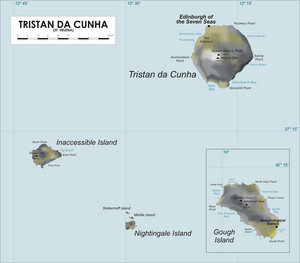Nightingale Islands


The Nightingale Islands are a group of three islands in the South Atlantic Ocean, belonging to Tristan da Cunha and part of the overseas territory of St Helena, Ascension and Tristan da Cunha.
The Nightingale Islands are all uninhabited. They consist of:
Nightingale Island is the smallest of the four main islands of the Tristan da Cunha Group, measuring only 1.5 square miles, and lies 19 miles away from Tristan and 14 miles from Inaccessible. Stoltenhoff and Middle Island, are really two large islets rather than conventional islands.
History
Originally named "Gebrooken (Broken) island" by the Dutch under Jan Jacobszoon in January 1656, they found no safe anchorage and did not make the first landing until 1696 (most likely by Willem de Vlamingh in August of that year). Frenchman D'Etchevery also visited the island in September 1767. Nightingale was renamed after British captain Gamaliel Nightingale in 1760. [1]
The American pirate Jonathan Lambert came here and sought to claim Tristan and its islands as his own. He unilaterally decided to change the name to "Lovel Island" in his 1811 proclamation in the "Boston Gazette" but as with his other proposed changes (which is to say Tristan da Cunha Group to "Isles of Refreshment") the name did not catch on, and Lambert was dead the next year.
Wildlife
Nightingale, a tiny island, is home to more than three million pairs of seabirds at a density of around 1.3 pairs per square meter; almost the entire vegetated island is occupied. Both the Nightingale and Wilkins's Buntings are found nowhere else in the world.
Important Bird Area
The Nightingale Islands group has been recognised internationally as a Wetland of International Importance under the Ramsar Convention and part of the Tristan da Cunha Endemic Bird Area (EBA). It has also been identified as an “Important Bird Area” by BirdLife International as a breeding site for seabirds and its endemic landbirds.
Birds for which the “Important Bird Area” is significant include northern rockhopper penguins (up to 125,000 breeding pairs), sooty albatrosses (up to 250 pairs), atlantic yellow-nosed albatrosses (5000 pairs), broad-billed prions (10,000 pairs), soft-plumaged petrels (up to 1000 pairs), great shearwaters (up to 3 million pairs), white-faced storm petrels (10,000 pairs), white-bellied storm petrels (1000 pairs), Antarctic terns (up to 400 pairs), southern skuas (up to 500 pairs), Tristan thrushes, Wilkins's buntings and Nightingale buntings.[2]
References
- ↑ Faustini, Arnaldo. "The Annals of Tristan da Cunha: The Early History of Tristan da Cunha."
- ↑ "Nightingale Island group". Important Bird Areas factsheet. BirdLife International. 2012. http://www.birdlife.org. Retrieved 2012-10-26.